|


Click below to skip to individual topics:
Celebrating a Second Birthday ... Keep it Simple ... Riding Toys Without Pedals
What to Do When Your Child Can't Do Things ...
Running Around ... Walking Backward
Boo-Boos ... Attitudes Are Catching ... Very Simple Puzzles ... Lotto
Old-Fashioned Pegboards are Fun for Children This Age ... So Are Big Wooden Beads
Carpentry & Children ... Tape Collage ... Playing with Dolls ... Dress-Up
I Can Take Off My Shoes ... But I Can't Put Them Back On ... Imitating What Adults Do
How to Drive a Car ... Watch Your Language ... And Your Actions
Following Simple Commands ... Please & Thank You ... Using the Third Person
Experience & Language ... Libraries & Bookstores ... Quality Time? ... Chores Can Be Fun
Chefs for the Day ... Where Does Food Come From? ... Good Days ... Bad Days
Welcome to the terrible twos. 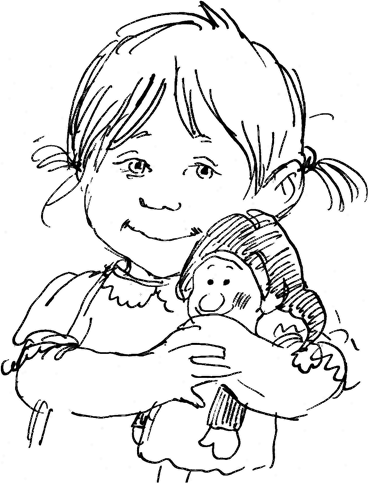
No doubt, you have been warned about the terrible twos. Two-year-olds are legendary; they vie with adolescents as the most challenging age group to raise. Twos (and adolescents) are known·for their tempestuous moods. You may have seen other toddlers have tantrums and sworn that your child never would. And, in fact, your child may pass through the next year without ever having one. If not, the advice offered in this chapter and others that follow will help you cope.
Parents have temper tantrums, too ..
We all blow our cool sometimes. We try to be rational role models for our children, but there are days when our kids drive us nuts, and for a moment, we can't take it anymore. So, we shout, count to 100, frantically hand the child off to another adult, or put the child in a safe room and shut the door. We may feel momentarily like hurting our children, but we don't, because afterward, we're glad that we didn't because it's harmful, and useless, and because, when they're not being terrible, twos are absolutely terrific.
Welcome to the terrific twos.
The same little devil who drove you crazy an hour ago is now a little angel calm, sweet, interested, friendly, loving, cooperative. Our children must learn from us that we can take them at their worst and that, while at times we don't approve of their behavior, we always love them.
Our children learn to take us at our worst, too, as long as our worst is not too bad. Tolerance and patience are outstanding qualities for children to learn.
Our children need to trust that while we all flip out from time to time, we won't flip too far. We'll bounce back, and so will they.
Celebrating a Second Birthday
Hints for giving a successful party:
1. Keep it small and short. Two to four children for one hour is plenty. Tell parents specifically when the party begins and ends. Invite parents to stay.
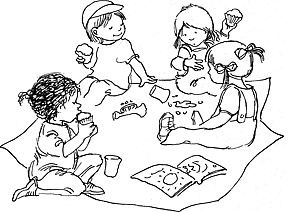 2. Serve a simple snack, such as cupcakes with no frosting, ice cream cones (after the cupcakes), and juice. Put a tablecloth on the floor. 2. Serve a simple snack, such as cupcakes with no frosting, ice cream cones (after the cupcakes), and juice. Put a tablecloth on the floor.
3. Play age-appropriate games, such as ring around the rosie and follow the leader.
4. Take photographs or videos.
5. For favors, send guests home with large pretzels or paint-with-water books.
Keep it Simple
Less is more. Less hype during the days and weeks before a party will bring more pleasant times during the party. Fewer people at the party will bring more contentment all around. Fewer presents, food, favors, and so on will bring to the party an element of peace. Less wound-up children, especially the birthday child, will bring more smiles.
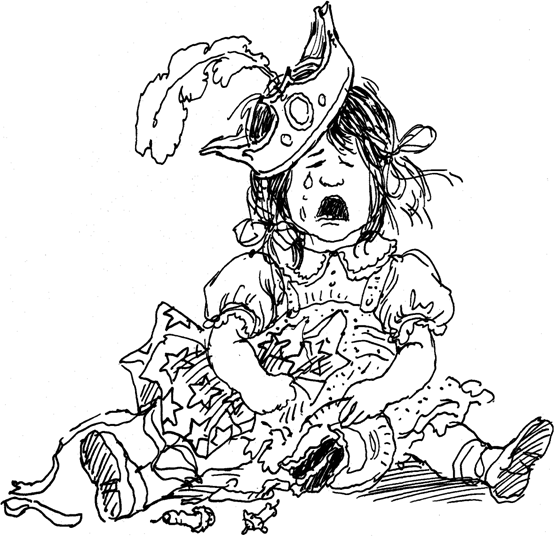
Riding Toys Without Pedals
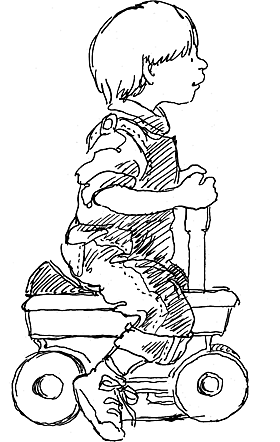 At this age the most desirable riding toys for children still have wheels but no pedals. Toddlers make the vehicles go with leg power. They may have been riding this kind of a toy since they were younger, or they may be riding it now for the first time. It doesn't matter. The most important thing is not to push your child into riding toys with pedals. They are difficult for toddlers to manage, and there is plenty of time for them later. At this age the most desirable riding toys for children still have wheels but no pedals. Toddlers make the vehicles go with leg power. They may have been riding this kind of a toy since they were younger, or they may be riding it now for the first time. It doesn't matter. The most important thing is not to push your child into riding toys with pedals. They are difficult for toddlers to manage, and there is plenty of time for them later.
Some riding toys have four wheels, others have three. The basic requirement is that they are solid and that your toddler can manage them without tipping over. Watch your child as he or she tries the vehicles that belong to other children. See what seems to be the most comfortable, most fun, and safest for your child.
Some riding toys for this age group come with sirens and annoying horns. If your child rides at home and these sounds disturb the family too much (they can be loud!), you might want to dismantle them. After all, things do break sometimes. A white lie, but, hey, they're loud!
What to Do When Your Child Can't Do Things
When your child can't do things, you can usually psyche out the reason. Your child may be too tired to try, or too hungry, or too sick, or even too bored. Your child may have wanted to do something else. Or your child may find the task too hard. In any of these cases, the best thing to do is to stop the activity and move on to something else that suits your child's needs.
Sometimes; however, a child needs your help in doing something. If a puzzle, for example, is too hard, you can adapt it to fit your child's ability by helping him or her - in the same way that sometimes you might simplify a story when you realize it's going over your child's head. You can make a game of having your child hold your hand while you find the right place for the puzzle piece, and then together you can shout, "Wow!" The point is to make the experience successful for your child. In other words, make the experience doable.
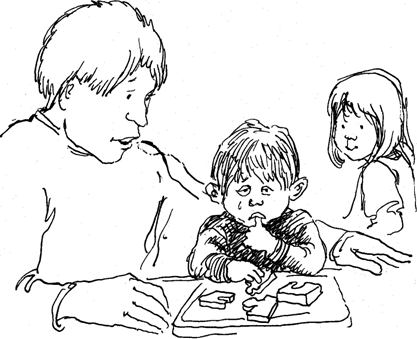
Running Around
As children get older, they like to run around more and more. Often, it seems that they'd rather run than walk from one place to another. They need space to run around in so they like to be outside in the backyard or the park. They like to run around with other children, too. They seem to know that the best way to get stronger and better at running is to practice.
Given that your child has a safe space to run around in and some companions, you can rest on a park bench and supervise from there. Make sure they don't run out of your sight, though, which can happen quickly.
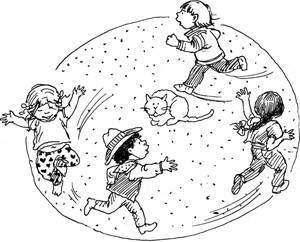
Walking Backward
The first step forward is a well-celebrated happening in a child's life. But the first step backward, which usually happens in the coming months, often goes unnoticed. From time to time, show your child how to walk backward. Make it a fun activity, not a demanding one. Sooner or later, your child will be able to do it. Now you can play more games. Sit in a chair and say, "Can you walk backward to me?" This is fun for children because they don't know quite when they'll reach you. At that time, of course, you hug your child and maybe even engage in a little belly tickling, too. It's always good "to supply language, such as; "You're getting closer, closer, closer ... GOTCHA!"
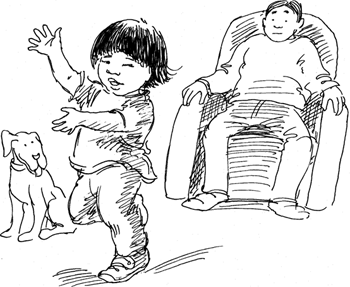
Boo-Boos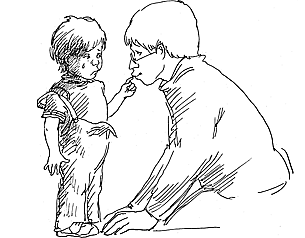
Toddlers get little boo-boos - injuries that are not very serious. When they get them, the best thing to do is be calm. Don't overreact and scare your child. Acknowledge your child's feelings, and offer the best remedy there is for a boo-boo: a kiss. On a more serious level, you also should know how to treat cuts and bruises, have your doctor's number handy, and have thought through ahead of time where you would want to take your child in a medical emergency. It's wise to keep a first-aid book in your home.
Attitudes are Catching
The way you see your child will be reflected in the way your child sees him- or herself. If there's something about the way your child looks that bothers you, discuss it with your wife, friend, and doctor, but don't discuss it in front of your child. Your child hears things you may not realize she is hearing.
Be positive about your child to your child.
Very Simple Puzzles
Single-shape puzzles.
These puzzles have big pieces that each depict one object, such as an apple or a bear. Sometimes each piece has a tiny knob on top. The handles make it easier for young children to manipulate the pieces.
Puzzles you can make.
Cut an old calendar picture into four pieces. Show your child the picture with the pieces put together. Then mix up the pieces and help your child put them back in order. Make sure the picture is comprehensible to your child.
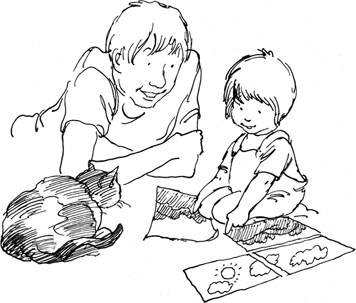
Lotto
 Lotto is a simple game, easy enough for toddlers to play. To play lotto, children match pictures with pictures. To make the most of the game, you can play too, helping your child match and name the objects as they are matched. Lotto is a simple game, easy enough for toddlers to play. To play lotto, children match pictures with pictures. To make the most of the game, you can play too, helping your child match and name the objects as they are matched.
Lotto games are usually found near the puzzles in toy stores.
It's also easy to make lotto games. All you need are sets of matching pictures. Paste one set on a cardboard base, and use the other set as matching cards. You can make the cards more sturdy by pasting them on index cards and cutting them out. The next time you receive two copies of the same catalog, don't throw one away. Use the catalogs to make lotto games.
A more complicated kind of lotto is where you match pictures to letters, or numerals to sets of objects that contain the right amount. These games are for future years. For now, matching pictures is enough.
Old-fashioned Pegboards Are Fun for Children This Age
You and your parents both may remember playing with pegs and pegboards in your childhoods. This toy continues to fascinate children today. They have the manual dexterity to pick up the pegs and insert them into the little holes on the pegboard. They may like to fill up the entire pegboard or to make simple designs with different color pegs. There are more modern variations of this game, usually involving somewhat bigger plastic pegs. These are fun, too.
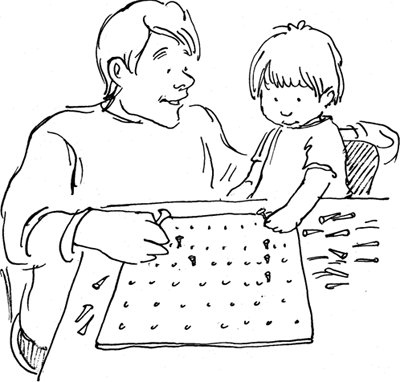
So Are Big Wooden Beads
Both pegboards and big wooden beads help children strengthen eye-hand coordination. Threading a lace through a bead involves some of the same skills required for inserting a peg in a pegboard. The beads should be about one inch in diameter with large holes for easy stringing. If the laces are difficult to thread, your child will need, and enjoy, your help. The beads don't have to be wooden; plastic ones are fine, too. As your child grows, he or she can make necklaces with patterns and also can try to match a pattern that you draw or make yourself. But for now, just make simple necklaces together.
Carpentry & Children
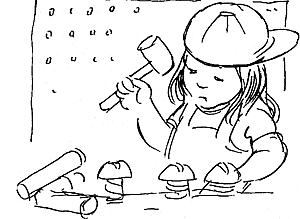 You can buy or make little toy carpentry benches for children. The best ones have pegs that can be hammered into holes with a wooden mallet, big screws that can be screwed by hand easily into big threaded holes, and a pegboard with pegs. Commercial carpentry benches for children this age are quite safe. If you make a carpentry bench for your child, follow directions for one made for toddlers. Be sure all parts are safe and easy for your child to work. You can buy or make little toy carpentry benches for children. The best ones have pegs that can be hammered into holes with a wooden mallet, big screws that can be screwed by hand easily into big threaded holes, and a pegboard with pegs. Commercial carpentry benches for children this age are quite safe. If you make a carpentry bench for your child, follow directions for one made for toddlers. Be sure all parts are safe and easy for your child to work.
When your child is about five or six, you can build small wooden toys and birdhouses together. Children like to learn how to use real tools, but they need you right there with them every moment because real tools can be dangerous.
Tape Collage
Masking tape is a great, inexpensive collage material for toddlers. They can rip off pieces and stick them down all by themselves. They can lift off pieces of their designs and rearrange them. Do not squander this useful resource. Save it for when you're on the phone with a client or the plumber and when you need your child to be quiet. In fact, it's not a bad idea to keep a roll of masking tape in your office or near the phone. You might even want to have different colors of it. If your child can't rip the tape, you can probably do it and talk on the phone at the same time, right?
Playing with Dolls
 Dolls enable children to enjoy feeling grown-up and nurturing - like you! Most people today recognize that boys as well as girls relate to dolls. If you like, you can provide your toddler with anatomically correct boy dolls. Dolls enable children to enjoy feeling grown-up and nurturing - like you! Most people today recognize that boys as well as girls relate to dolls. If you like, you can provide your toddler with anatomically correct boy dolls.
Doll clothes:
It's not easy for toddlers to take clothes off of dolls if the clothing is too complicated or too tight. You might want to suggest that your child put some of his or her own clothes on the doll, perhaps old clothes that are outgrown.
Clothing toys:
Some dolls are made with special clothes that are designed to help children practice the skills of manipulating buttons, zippers, laces, socks, and shoes. Certain baby books help children learn these skills, too.
Dress-Up
Children like to play dress-up, trying on different clothes that belong to special people, such as parents, grandparents, clowns, firefighters, police officers, dancers, and so on. Start a collection of dress-up clothes in a big box or basket. Add to it over the years.
Dress-up is a good dramatic play activity for toddlers to enjoy with their friends. So, for now, only put dress-up clothes into the basket that they can handle, or else be prepared to help them.
Simple dress-up items for toddlers are hats, scarves, and mittens. Children particularly like hats that represent different jobs, such as firefighter hats and cowboy hats.
I Can Take Off My Shoes ...
As irritating as toddlers can be, you have to feel sorry for them. They inadvertently set themselves up for failure. No wonder they sometimes get so mad! In their desire to learn new things and experience the world, they get into situations that they can't control. In this way they frustrate both themselves and their parents.
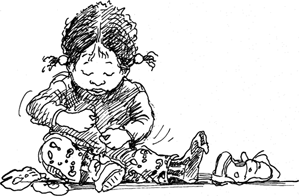
You often see this problem acted out by toddlers in the realm of dressing and undressing. Clothes are physical, and some toddlers are very aware of certain textures touching their skin. Often, if they don't want to be wearing a particular item of clothing, they will just take it off. Other times they'll take off clothing just for the heck of it. And sometimes they'll take it off merely because they can - or think they can and want to try.
Once they get their shoes or clothes off, they may not be able to put them back on again. Sometimes they don't care, but you do. And sometimes you don't care, but they do, which you, no doubt, will hear about.
... But I Can't Put Them Back On
When you are in a hurry to go somewhere and your child has just taken off his or her shoes, you may feel your blood pressure start to rise. "I just put those shoes on you!" you shout. "Why did you take them off?" Your toddler starts to cry, and you feel like crying, too. These are the little times that try a parent's soul.
One thing you can do is acknowledge your child's predicament. Saying it aloud may help your child understand the situation. You might say something like, "You have learned to take off your shoes, and that's good. But now is not the time to do that. Tonight when you go to bed, you can take off your shoes all by yourself. Now, I'm going to put them back on, and I'd like you to leave them on, okay?"
If your toddler won't cooperate and it's time to leave, stick the shoes in your pocket and carry your toddler. You can't win 'em all.
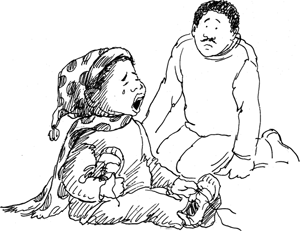
Imitating What Adults Do
Children want to grow up. They want to become big people and do what big people do. Consequently, they like to have childsize tools and work equipment. They like little brooms and rakes that work. They like little gardening tools, tea sets, pots and pans, and furniture that looks like adult furniture.
They also like to go to adult places, such as stores and offices, with you. But if you take your child with you to your office, don't expect that he or she will play quietly in a corner while you work. Toddlers can't do that, so just stop by for a short visit.
How to Drive a Car
Get a big box. Climb in. Hold on to a hoop or toy driving wheel, and drive! Large empty boxes provide good opportunities for children to act out fantasies. Boxes can be cars one minute, trains the next, and then a house - all in short order. All you need to do is provide the box and make a suggestion.

Watch Your Language ...
Your attitude toward your wife and women in general is the model your child sees and hears. Different families have different arrangements for sharing household work. Whatever your arrangement is, your child is learning from it. If you refuse to help out at home, you can be sure that your child sees that. If you are critical of your wife's efforts, you can be sure that your child sees that, too. By your behavior, you teach your child what men and fathers are like.
... And Your Actions
There's nothing wrong with a little healthy anger freely expressed. But again, be aware that your child may be watching you. Anger that gets out of control is frightening to a child. Sometimes knowing that your child is watching you can be the factor that helps you decide to stay cool and maintain control. In this way, children can inspire us as parents to get our acts together.
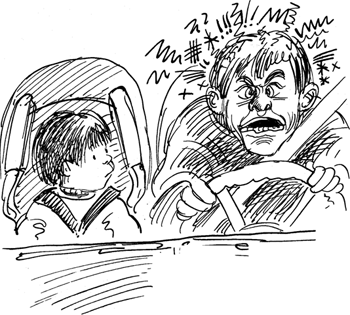
Following Simple Commands
Two-year-olds are now able to follow simple commands, such as "Give me the crayon" and "Put the spoon in the bowl." They comprehend what you want, and often they oblige obediently. Reward such positive behavior with praise. The praise doesn't have to be lavish; it can just be an appreciative smile and a simple "Thanks." Sometimes your toddler will not oblige you. Before you get angry, check to make sure that your child has heard you, understands what you want, and that your request is reasonable. If your child still won't do what you want, offer a distraction, such as a toy in exchange for the remote, or get what you want by yourself, ignoring your child's truculence.
Please & Thank You
Please and thank you are often presented to children as magic words, and in a way, they are. They make people feel good. When your child takes a gift from you, you can ask, "What do you say?" Teach your child to say, "Thank you," or just "Thanks." He or she may not be able to pronounce it correctly and may not even understand what it means, but your child will grasp the notion of when it is appropriate to say it and that the word makes you happy. The same goes for "Please" when your child wants something. And, of course, it goes without saying, if you want your child to use the words please and thank you, you have to use them yourself.
Using the Third Person
Two-year-olds do not understand when to use the personal pronoun "I" to say, for example, "I go out." They refer to themselves in the third person and will do so probably until they are about three and a half. Their sentences now usually contain two to four words.
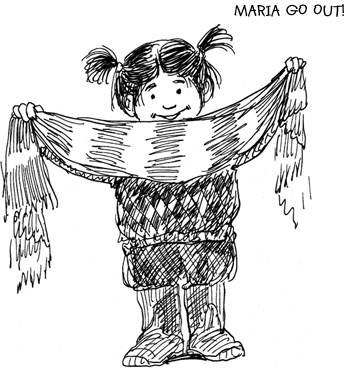
Experience & Language
Young children learn from concrete experiences. They can learn what doggie means by looking at a picture, but the learning is deeper and more meaningful if they learn the word from real-life experience. Everywhere you go with your child is an opportunity for you to introduce your child to new words: gas pump, corn flakes, tomato, monkey, shell, shovel, pizza, tortilla.
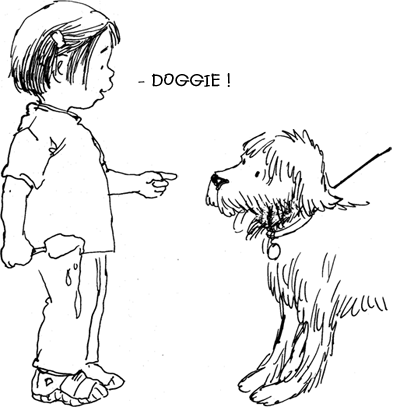
Libraries & Bookstores
Two of the best places to take your toddler are the bookstore and the library. Many of these places have special read-aloud times for toddlers. Such events provide an opportunity for you to meet other parents and for your child to meet other toddlers, as well as for both of you to enjoy books.
Quality Time?
Quality time is when you and your child both do the same thing and you give your child your full attention. Now, no parent can provide quality time all the time. That would be too hard on both the parent and the child, who would end up craving a few minutes behind the couch with her doll while Dad watched TV. But all children need some quality time each day. Your child will let you know if he or she isn't getting enough by whining, clinging, and using other toddler tactics to demand your attention.
Chores Can Be Fun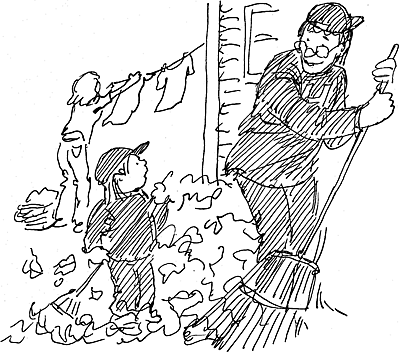
Doing chores with your toddler can be fun - on three conditions:
1) that you have enough time,
2) that there's something your toddler can really do, and
3) that the chore doesn't last too long.
If you're trying to get a job done fast, you will only be annoyed at your toddler's ineptness. Toddlers don't just stand and wait. If there's nothing for them to do, they will find something to do, and it probably will be something that drives you crazy.
Chefs for a Day
Children love to cook because they get to experience new things to touch, smell, and taste. They also get to experience how ingredients change when they're mixed and baked. So cooking is great for children, but remember, when you bake with children, everything takes three times longer.
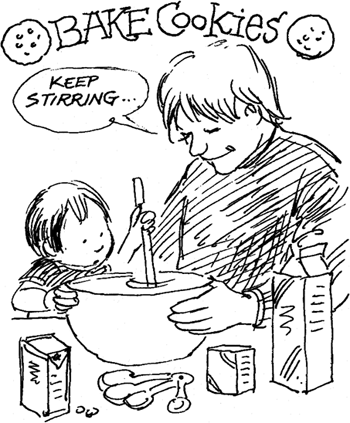
Where Does Food Come From?
Kids today can enter first grade without knowing where food comes from. They think orange juice and peas come from boxes in the refrigerator. Help your child make the connection between food and nature at an early age.
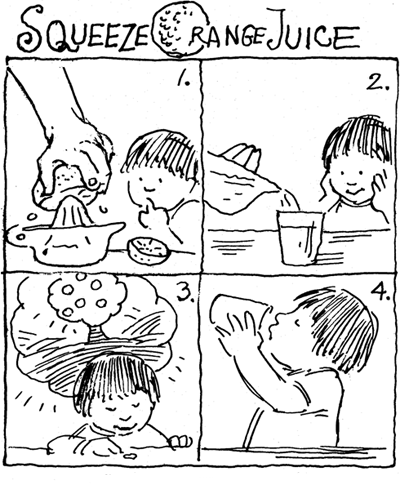
Good Days
 Good days are when your child plays with other children at your house, Good days are when your child plays with other children at your house,
and no one fights
and it doesn't rain ...
and no one refuses to eat the crackers you offer,
and no one spills a cup over ...
and no one gets hurt,
and no one clings to you ...
and no one throws up,
and all the parents come on time to pick up their kids.
Bad Days
Bad days are when you wanted to work quietly at home, but the day care closed because of freezing rain, and two parents asked if you could watch their kids too, and you couldn't go out, and your daughter wouldn't share her new doll, not even for a minute, and one boy cried all day for his mommy, and the other boy was a biter, and because of the weather your wife and the other two parents all came home two hours later than anticipated. The truth is, all parents have good days and, unfortunately, all parents have bad ones, too.
CLICK FOR CHAPTER FOUR
|

